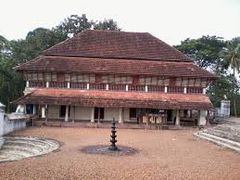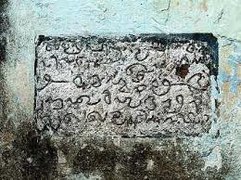Kadamattathu Kathanar

Kadamattathu Kathanar ( a Jacobite Church priest of Kadamattom church) also known as Kadamattathachan (Father Kadamattom) is a priest (Kathanar) who is believed to have possessed supernatural powers and whose legends are closely related to the beginning of the Kadamattom Church, one of the oldest church buildings that still exists in Kerala the land of Saint Thomas Christians.[1] The church belongs to the Syrian Orthodox Church which stands on a hill about 30 km from Ernakulam on the Moovattupuzha road. The history of this church was not written down, but lives through legends. The stories about Kadamattathu Kathanar embody the exaggerated experience of the people in that area giving expression through magic and sorcery. The stories relating to him tells that he had supernatural powers and being a Christian priest used his magic for the common good.[2]
In medieval legends, history and fables were combined inextricably.[3] The story of Kadamattathu Kathanar might be a mixture of history and fables. Currently there is no certain proof that he really existed, but the fact that a real priest lived in that area in the ninth century cannot be denied.[4] Tradition points out the existence of Christians in the area from 5th century of the Christian Era.[5]

Childhood
Poulose was born in a very poor Syrian Christian family in Kadamattom, a small village in North Travancore (now part of Kerala). People fondly called him Kochu Poulose. He had no siblings and his parents died when he was a child. He was taken care of by his mother for a short period before her death after which he came under the patronage of the Persian priest Mar Abo.[8] Living in a small cottage with no one to look after, he felt depressed, left his home and went to a nearby church. The parish priest who passed that way saw this boy crying and praying on the doorsteps of his church. He took him to his house gave him shelter and food and cared for him like his own child.
Soon the parish priest had realized that this boy was religious, intelligent and efficient. So he was given a good education under a famous teacher. The priest himself took time to teach him Syriac and Liturgy of the Mass. In due course he was ordained as a Deacon and people began to call him Deacon Poulose.
Mastering of Magical Powers
According to a popular legend, a local priest had a herd of cattle which were taken out by a servant boy to the nearby hills for grazing. One day while he was out with the cattle on the hills, a tiger came and killed one of them. Afraid of the tiger the boy ran to the village and told the priest what had happened. The priest and Deacon Poulose, immediately summoned the people in the village and they went out in different directions searching for the cattle. By sunset all the cattle returned, except the one that was killed by the tiger.
But soon the priest realized that Deacon Poulose, who went in search of the cattle, did not return. Search parties went out in different directions that night. But there was no sign of the deacon. Days passed by, still he had not returned. Though the villagers thought that he was killed by the tiger, the priest believed that he was still alive somewhere.
Paulose had actually lost his way in the deep forest which eventually led him to a group of ancient tribals. It is believed that he mastered his magical powers from these cannibal tribes known as Mala Arayas living in subterranean abodes. Their leader who became fond of Paulose, allowed him to stay with them for many years during which he learned the secrets of magical performances.
Paulose later escaped from there after which the Mala Arayas searched for him in vain. It is believed that Kathanar escaped by staying in the church when the cannibal tribes created a storm in their effort to destroy the church and capture him. The scars said to be generated by the storm are still visible on the walls of the church.
Mar Sabor the Bishop who ordained him as a priest left from Kadamattom after the arrival of Paulose. The Bishop built many churches,[9] Kayamkulam and finally settled at Thevalakkara,[10] his tomb inside the Martha Mariam Church Thevalakkara.
It is difficult to detail all the great deeds in the life of Kadamattathu Kathanar as not many verifiable records exist. He has written a number of books on sorcery but his writings are not legible and is incomprehensive to the lay reader.
Last days
Neither his date of birth nor date of death are known. Till the end of his life, he did not reveal from where or from whom he received lessons on sorcery. It is believed that he went into a cave and disappeared. The cave, which is located beside the church is still preserved.
Gallery
-
Famous Persian Cross- front view
-
Persian Cross-side view
-
Altar of the church
-
External view of the church
-
Tomb of Marthoma IX
-
Bishops rest room built in the late 1940s or earlier
-
Unknown inscription on the wall of the church
In Media
- In the 1966 film Kadamattathachan, Prem Nazir played the lead role.
- A popular TV series Kadamattathu Kathanar was telecasted by Asianet in which actor Prakash Paul played Kathanar.[11][12]
- A similar TV series was produced by Jai Hind television channel and by Surya TV (titled Kadamattathachan). Prakash Paul played the title role in both.[13][14]
- Past films and TV series had inaccurately portrayed Kadamattathu Kathanar as a Capuchin priest. He was a priest in the Jacobite Syrian Church. Hence he wore the traditional attire of priests from the Assyrian church such as the phiro (a small black cap) and the black robe.
- In the movie Megasandesam cast by Suresh Gopi & Samyuktha Varma actor Napoleon plays the role of a descendant of Kadamattathu Kathanar.
- On February 14, 2020 Friday Film House announced a movie called Kathanar which is based on the character starring actor Jayasurya in the titular role.
See also
References
- ^ "Wikibooks Malayalam- Aithihyamala- Kadamattathu Kathanar". Wikibooks-Malayalam. 7 June 2011. Retrieved 10 June 2011.
- ^ "Kathanar's Kadamattam". The Hindu. 18 February 2005. Retrieved 11 May 2011.
- ^ "A symbol of amity". The Hindu. 1 August 2004. Retrieved 17 May 2011.
- ^ "Chera times of the Kulasekharas". kerala.cc. Retrieved 17 May 2011.
- ^ Kottoor_kulangattil Family Magazine 2012 (Kottoor Church History)
- ^ A. K. Shrikumar (2001), Stories from Ithihyamala: fables of Kerala, Children's Book Trust, pp. 79–94, ISBN 9788170119036
- ^ Kottarathil Sankunni. EithihyamaalaIythiha Maala (legends of Kerala). Chapter 72. pp 380-391.
- ^ "St. Mar Abo festival". The Hindu. 28 January 2011. Retrieved 17 May 2011.
- ^ Joseph, Thomas. "Mor Sabor-Mor Aphroth, Akaparambu". sor.cua.edu.
- ^ "Archived copy". Archived from the original on 18 February 2013. Retrieved 23 October 2012.
{{cite web}}: CS1 maint: archived copy as title (link) - ^ "Kadamattathu Kathanar". The Hindu. 30 April 2004. Retrieved 17 May 2011.
- ^ "Bhavan's Adarsh Vidyalaya emerges winner". The Hindu. 3 October 2004. Retrieved 17 May 2011.
- ^ "TV Listings- Surya TV". tvlistings. Retrieved 17 May 2011.
- ^ "Jai Hind- Serials". The Hindu. 8 February 2008. Retrieved 17 May 2011.
Further reading
- Kottarathil Sankunni, Aithihyamaala (legends of Kerala in Malayalam). Current Books. 1909. ISBN 81-240-0010-7.
- Mathew, N.M. Malankara Marthoma Sabha Charitram, (History of the Marthoma Church), Volume 1. Tiruvalla. 2006.







